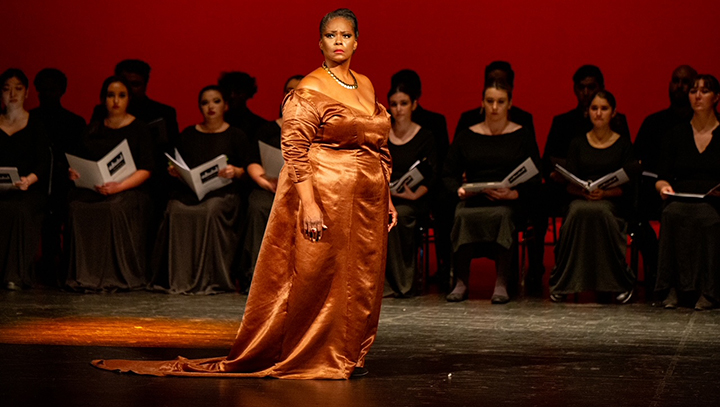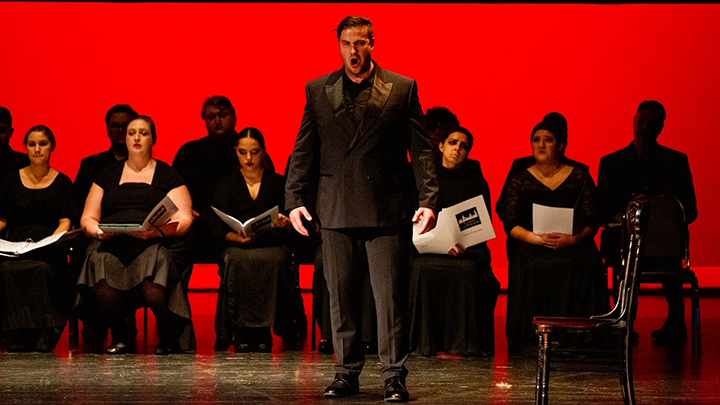
Gaspare Spontini’s La Vestale (1807) has been one of those historically important operas that you read about but never see performed. Composed in French, it was an enormous success in Paris and established Spontini as the favorite composer of Napoleon and Empress Josephine and a dominant figure in the international music scene. Beethoven, Berlioz and Wagner admired the work and it influenced every other 19th century composer, either directly or indirectly. La Vestaleis a crucial transitional work that bridges the classicism of Gluck’s reform operas, the innovations of Cherubini’s Paris works like Medée with emerging elements of Romanticism clearly paving the way towards the French Grand Opera.
Most opera fans know the work from the solo recordings by Rosa Ponselle and a pirated recording (in Italian) of a December 1954 revival at La Scala with the legendary Maria Callas flanked by the strapping Franco Corelli, Ebe Stignani and Enzo Sordello in a production directed by Luchino Visconti.
It was last staged in New York in Italian in the 1925-1926 season for Rosa Ponselle and served for the opening night of the following season. In January 1963, it was revived (in the original French) in concert by the Concert Opera Association conducted by Thomas Scherman with Régine Crespin as Julia with tenor John McCollum and mezzo-soprano Mary Davenport in the cast. In the New York Times, Harold C. Schonberg dismissed the work as soporific and a relic from the past. And the rest was silence.
It was in honor of the upcoming centennial of the birth of Maria Callas on December 2nd, that Teatro Grattacielo revived the work, in the Italian version, on Saturday, October 28th for one night only in a semi-staged concert at the Gerald Lynch Theatre at John Jay College. This was something of a departure from Teatro Grattacielo’s initial purpose in reviving lesser-known Italian verismo works. That might explain why the performance came off rather unsteadily. The Italian version that has generally been more often performed (until recently) stems from an 1811 production at the Teatro San Carlo which starred Isabella Colbran (later the muse and first wife to Gioachino Rossini) and the baritenor Andrea Nozzari. The translation (altered to fit Italian verse forms, thus altering the prosody and musical form) was by Giovanni Schmidtwho was also the librettist for Rossini’s early Neapolitan operas like Armida and Elisabetta, Regina d’Inghilterra. The vocal line sits more gracefully on the music in French but I can see why the choice was made to perform it in the Italian version.
To get right to the point, the performance did not come together despite some good elements and was a major missed opportunity. The score was well conducted by the animated Christian Capocaccia with a competent full orchestra. However, the sound engineer turned on the sound system mics in the first act, despite the John Jay auditorium being fairly intimate, resulting in overly resonant edgy acoustics that distorted the balances and the texture of the playing. The mikes were turned off after the one intermission before acts 2 and 3. The chorus was cobbled together from professional choristers under the direction of Jason Tramm supplemented by students from the Frank Sinatra School for the Arts High School in Queens. The chorus did not come together as an ensemble with certain individual choristers sustaining the vocal parts while the rest were inaudible or musically lost.
The direction was by company director Stefanos Koroneos which mainly consisted of singers entering and leaving from stage left or right with two wooden chairs for them to sit in while the chorus was lined up behind them. Koroneos said that he was stressing the “static oratorio” qualities of Spontini’s opera which I think was a mistake – the work has much spectacle and drama contrasting an internal psychological drama with epic scenic tableaux. Dramatic and musical flatness pervaded the performance which seemed under rehearsed. Costume and scenic artist Lydia Venieri did not provide much in way of extra visuals – the men wore black slacks and jackets, the women long concert gowns with no scenic elements or props. During the overture, the decision was made to provide us with non-stop vertigo-inducing animated video projections by Vaibhavi Deo, Rozina Vavetsi and Michael Hosenfeld drawing doodles of moving columns and temples with falling stars. It added nothing and was very distracting from the music.
The video screen remained above the singers with projected titles and helpful illustrations depicting images of ancient Roman temple interiors, public forums, etc. The projected English translations were so inaccurate and garbled that they reduced the text to nonsensical word salad confusing the listener. For example, the word “proscritto” was translated as “prescribed” rather than forbidden or banished.
The cast was a decided mixed bag that lacked a galvanizing prima donna in the title role. The most successful performer was the young Welsh tenor Thomas Kinch in the low-lying tenor role of Licinio (Licinius in the original). His ringing spinto tenor voice had a dark baritonal center (the part has been cast with high baritones as well as tenors) that opens up to a ringing top. He seemed fully in command of his music and projected the vocal line with energy throughout.
In supporting roles, Sri-Lankan mezzo-soprano Tahanne Aluwihare as the forbidding Gran Vestale started out promisingly with an imposing vocal and physical presence. However, she seemed to lose her way: the tone and phrasing lost focus, her musical attacks lost precision and shallowness and harshness invaded her delivery. Baritone Kyle Oliver as Licinio’s comrade and friend Cinna (a role also sung by either tenors or baritones), seemed rather callow and recessive in a part that requires stalwart authority and energy. Bass Eric Lindsey was solid but unmemorable as Il Sommo Sacerdote – a role that provided Ezio Pinza with his Metropolitan Opera debut on the Met opening night in 1926.
The role of the errant vestal Julia (or Giulia in Italian) carries the opera musically and dramatically – she has four exposed solos and her emotional travails provide the focus for the music drama. The opera musically and dramatically centers on her emotional life. So the opera rises or falls on the skills of the prima donna. The work is identified with transcendent prima donnas – Alexandrine-Caroline Branchu (born in Haiti of mixed race) in Paris in 1807, Isabella Colbran in Naples in 1811, Wilhelmine Schröder-Devrient in Dresden in 1844 conducted by Richard Wagner, Rosa Ponselle at the Met and Florence in 1925-26 and 1933 and Maria Callas in Milan in 1954. Other revivals have centered on Ester Mazzoleni, Maria Caniglia, Leyla Gencer, Montserrat Caballé, Renata Scotto and more recently Ermonela Jaho, Maria Agresta and Elza van den Heever in French.
Teatro Grattacielo is in a difficult situation in that they cannot afford international stars. (One international soprano was offered the role but her agent held out for more money than their budget allowed.) The best solution would have been to find a young, rising spinto soprano with sensitive expressive gifts on the threshold of her career, if one is out there. Instead, the semi-retired Indra Thomas was tapped for the title role. Thomas was making waves 30 years ago (she has a brief cameo in the 1989 movie Driving Miss Daisy as a church soloist) and had an international career singing roles like Aida and garnering Grammy and Emmy nominations for her work. Still major operatic stardom eluded her and lately Thomas has been concentrating on teaching. This was her return.
Thomas revealed a luscious soprano voice of great timbral beauty but problematic equalization and registration. The voice had many of the good and bad qualities of Leontyne Price’s late career – the blowsy and unfocused middle range opening up to radiant lush tones in the upper register reached by scooping and hooking into the notes. I was also reminded of Leonie Rysanek’s hollow middle voice that seemed to be collapsing under the weight of a huge upper register with attendant flattening and wandering pitch. The role of Giulia requires in her great arias “Tu che invoco” and “O Nume tutelar” a sculpted and even classical line with seamless legato throughout the registers. Thomas could not provide that despite the vocal glamor on high. Onstage she was a matronly but sincere performer with limited plastique and expressiveness with an overall affect of generalized sadness. There was still a voice there but not the technical command, dramatic authority or charisma. Unlike Callas, she let the fire go out on Spontini’s musical drama.
The unique virtues of Spontini’s La Vestale were not evident on this occasion and I can’t imagine other companies taking it up though they should. There is an excellent new recording of the French original on the Palazetto Bru Zane label with a vibrant Marina Rebeka as Julia under the baton of Christophe Rousset. There is a major revival at the Opera Bastille planned for June/July 2024 with Elza van den Heever as Julia and Michael Spyres as Licinius.
Spontini’s masterpiece is not dead but very much alive and kicking these days – but not on this side of the Atlantic.
Come on, baby, light Spontini’s fire!
Photos: Gustavo Mirabile & DoChong Tom




























Comments